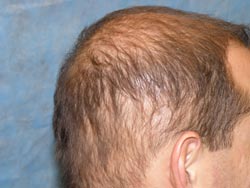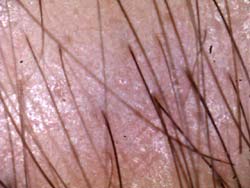Causes of Hair Loss in Men
By far the most common cause of hair loss in men is androgenetic alopecia, also referred to as “male pattern” or “common” baldness. It is caused by the effects of the male hormone dihydrotestosterone (DHT) on genetically susceptible scalp hair follicles. This sensitivity to DHT is present mainly in hair follicles that reside in the front, top, and crown of the scalp (rather than the back and sides) producing a characteristic and easily identifiable pattern described by Norwood (see
Norwood Classification).
It is frequently stated that “hair loss comes from the mother’s side of the family.” The truth is that baldness can be inherited from either parent. However, recent research suggests that the reasons for hair loss and balding may be a bit more complex than originally thought. Factors on the x-chromosome have been shown to influence hair loss, making the
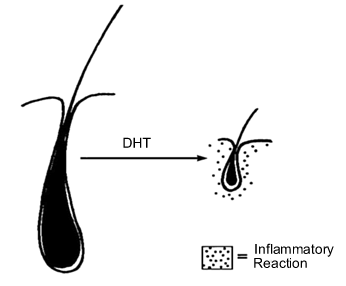
inheritance from the maternal side of the family slightly more important than the paternal one (
Markus Nothen, 2005).
The identification of an androgen receptor gene (AR) on the x-chromosome helps to explain why the hair loss pattern of a man resembles his maternal grandfather more often than his father. However, this is clearly not the whole story since a direct inheritance of baldness from the father is observed as well. An autosomal (non-sex) linked gene would explain this type of transmission – but this gene has not yet been found.
DHT is formed by the action of the enzyme 5-alpha reductase on testosterone, the hormone that causes sex characteristics in men. DHT causes male hair loss by shortening the growth, or anagen, phase of the hair cycle, causing miniaturization (decreased size) of the follicles, and producing progressively shorter, finer hairs. Eventually these hairs totally disappear.
In the patient below, we see a close-up of the side of his scalp where the hair is not affected by DHT. We see mostly groups of full thickness hairs (called terminal hairs) and a few scattered fine, vellus hairs. This is normal.
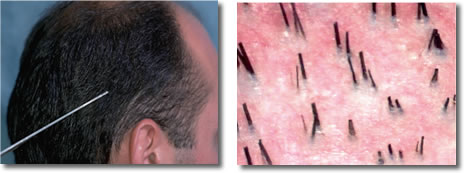
In the area of thinning (see circle below), we see that most of the hair has been miniaturized, although all of the hair is still present.
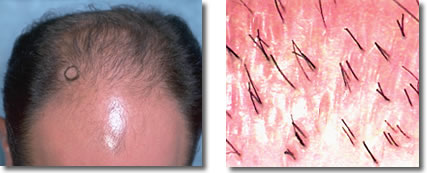
In the region that is balding (second circle in the center), there is extensive miniaturization and some, but not all of the hair has disappeared.
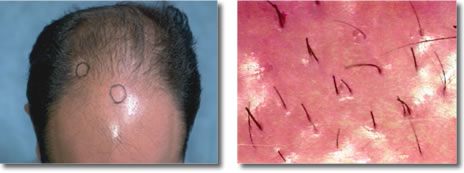
What this shows is that the initial appearance of balding is due to the progressive decrease in hair shaft size, rather than the actual loss of hair – in early hair loss, all the hair is still present. This is the reason why hair loss medications, such as finasteride (Propecia) work in early hair loss (since they are able to partly reverse the miniaturization process) but don’t work in areas that are totally bald. It is also the reason why men’s hair restoration surgery, if not planned properly, can result in hair loss due to the shedding of surrounding miniaturized hair.
More About Androgenetic Hair Loss and Balding:
Androgenetic hair loss is caused by three interdependent factors: genes, hormones, and age:
Genes
Common baldness cannot occur without the presence of specific inherited genes. These genes can be passed on by either parent. A gene is a single bit of chemically encoded hereditary instruction that is located on a chromosome and actually represents a tiny segment of DNA. Chromosomes occur in pairs (humans have 23 pairs), and every individual gets one set of chromosomes from each parent. Hair loss in men is now felt to involve more than one gene. When several genes govern a trait, it is called polygenic.
Genes that are located on the X or Y-chromosomes are call sex-linked. Genes on the other 22 pairs of chromosomes are called autosomal. It is felt that the genes governing common baldness are autosomal (not sex linked). This means that the baldness trait can be inherited from the mother’s side of the family or the father’s side with equal frequency. The commonly held notion that baldness comes only from the mother’s side of the family is incorrect, although for reasons not fully understood, the predisposition inherited from an affected mother is of slightly greater importance than that inherited from an affected father.
The term, “dominant” means that only one gene of a pair is needed for the trait to show up in the individual. A “recessive” gene means that both genes need to be present in order for the trait to be expressed. The genes involved in balding from androgenetic alopecia are felt to be dominant.
Just because one has the genes for baldness, it doesn’t mean the trait will manifest itself. The ability of a gene to affect one’s characteristics, i.e. be visible in a particular individual, is called “expressivity”. Gene expression is related to a number of factors, the major ones being hormones and age, although stress and other factors can be reasons for hair loss and balding in some individuals.
It is of interest that, although genes for some types of male hair loss have been mapped, none of the genes for male pattern baldness have yet been identified. This suggests that any kind of genetic engineering to prevent common baldness is still many years away.
Hormones
Hormones are biochemical substances that are made in various glands throughout the body. These glands secrete their products directly into the bloodstream so that the chemical they make is spread throughout the body. These chemicals are very powerful so that only minute amounts of them have profound effects upon the body.
The major male sex hormone is called testosterone. Testosterone and other related hormones that have masculinizing effects are made primarily in the testicles; therefore, the hormonal levels that are seen in adults do not reached significant levels until the testicles develop and enlarge during puberty. In fact, these same hormones are the cause of many of the changes that occur in puberty; growth of phallus and scrotum, sperm production, development of a sex drive, change in the voice, growth of axillary and pubic hair, development of an adult aroma in the sweat, increase in bone and muscle mass, and change in the basic body shape.
These same hormones that cause acne and beard growth can also signal the beginning of baldness. The presence of androgens; testosterone, and its related hormone DHT, cause some follicles to regress and die. In addition to the testicles, the adrenal glands located above each of our kidneys, produce androgenic hormones, and this would be similar in both sexes. In females, the ovaries are an additional source of hormones that can affect hair.
The specific relationship between testosterone and hormonally induced hair loss in men was discovered by a psychiatrist early in this century. At that time, castration was commonly performed on patients with certain types of mental illness as it seemed to have a calming effect upon many patients and castration reduced the sex drive of patients who had no outlet for their desires. The doctor noted that the identical twin brother of one patient was bald while the mentally ill (castrated) twin had a full head of hair. The doctor decided to determine the effect of treating his patient with testosterone, which had recently become available in a purified form. He injected the hairy twin with testosterone to see what would happen. Within weeks, the hairy twin began to lose all but his wreath of permanent hair, just like his normal twin. The doctor, then, stopped giving the testosterone to see whether the process would be reversed, but the balding process continued and his patient never regained his full head of hair. It was apparent to him that eliminating testosterone will slow, or stop, further hair loss once it has begun, but it will not revive any dead follicles.
The hormone felt to be directly involved in androgenetic alopecia is actually dihydrotestosterone (DHT) rather than testosterone. DHT is formed by the action of the enzyme 5-a reductase on testosterone. DHT acts by binding to special receptor sites on the cells of the hair follicles to cause the specific changes associated with balding.
In men, 5-a reductase activity is higher in the balding area. This helps to explain the reason for the patterned alopecia that males experience. The enzyme 5-a reductase is inhibited by the hair loss medication finasteride (Propecia).
DHT decreases the length of the anagen (growing) cycle, and increases the telogen (resting) phase, so that with each new cycle the hair shaft becomes progressively smaller. In addition, DHT causes the bitemporal reshaping of hairline seen as adolescents enter adulthood, as well as patterned baldness (androgenetic alopecia). DHT also causes prostate enlargement in older men and adolescent and adult acne.
It is interesting that testosterone effects axillary and pubic hair, whereas DHT effects beard growth, hair on trunk and limbs, patterned baldness and the appearance of hair in the nose and ears (something that older men experience). Scalp hair growth, however, is not androgen dependent, only scalp hair loss depends on androgens.
Age
The presence of the necessary genes and hormones is not alone sufficient to cause baldness. Even after a person has reached puberty, susceptible hair follicles must continually be exposed to the hormone over a period of time for hair loss to occur. The age at which these effects finally manifest themselves varies from one individual to another and is related to a person’s genetic composition and to the levels of testosterone in the bloodstream.
There is another time factor that is poorly understood. Male hair loss does not occur all at once nor in a steady, straight-line progression. Hair loss is characteristically cyclical. People who are losing their hair experience alternating periods of slow and rapid hair loss and even stability. Many of the reasons that hair loss rates speed up and speed down are unknown, but we do know that with age, a person’s total hair volume will decrease.
Even when there is no predisposition to genetic balding, as a patient ages, some hairs randomly begin to miniaturize (shrink in length and width) in each follicular unit. As a result, each group will contain both of full terminal hairs and miniaturized hairs (similar to the very fine hairs that occur on the rest of the body and are clinically insignificant) making the area look less full. Eventually, the miniaturized hairs are lost, and the actual follicular units are reduced in number. In all adult patients, the entire scalp undergoes this aging process so that even the donor zone is not truly permanent, but will gradually thin, to some degree, over time. Fortunately, in most people, the donor zone retains enough permanent hair that hair transplantation is a viable male hair restoration procedure even for a patient well into his 70′s.
Classification of Hair Loss in Men
Norwood Classification
The Norwood classification, published in 1975 by Dr. O’tar Norwood, is the most widely used classification for hair loss in men. It defines two major patterns and several less common types (see the chart below). In the regular Norwood pattern, two areas of hair loss–a bitemporal recession and thinning crown–gradually enlarge and coalesce until the entire front, top and crown (vertex) of the scalp are bald.
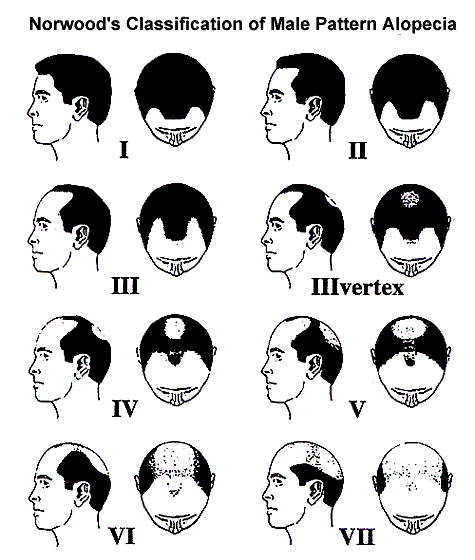 Class I
Class I represents an adolescent or juvenile hairline and is not actually balding. The adolescent hairline generally rests on the upper brow crease.
Class II indicates a progression to the adult or mature hairline that sits a finger’s breath (1.5cm) above the upper brow crease, with some temporal recession. This also does not represent balding.
Class III is the earliest stage of male hair loss. It is characterized by a deepening temporal recession.
Class III Vertex represents early hair loss in the crown (vertex).
Class IV is characterized by further frontal hair loss and enlargement of vertex, but there is still a solid band of hair across top separating front and vertex.
Class V the bald areas in the front and crown continue to enlarge and the bridge of hair separating the two areas begins to break down.
Class VI occurs when the connecting bridge of hair disappears leaving a single large bald area on the front and top of the scalp. The hair on the sides of the scalp remains relatively high.
Class VII patients have extensive hair loss with only a wreath of hair remaining in the back and sides of the scalp.
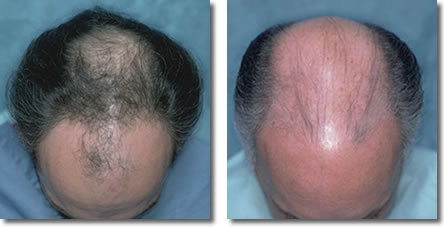
Left: Typical Norwood Class V showing two distinct areas of hair loss with the bridge of hair separating the front and back thinning significantly.
Right: Class VI showing the confluence of the front a back to form one bald area.
Norwood Class A
The Norwood Class A patterns are characterized by a front to back progression of hair loss. Norwood Class A’s lack the connecting bridge across the top of the scalp and generally have more limited hair loss in the crown, even when advanced.
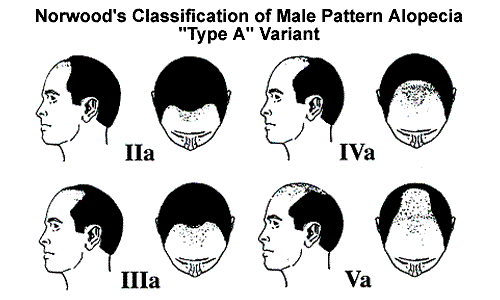
The Norwood Class A patterns are less common than the regular pattern (<10%), but are significant because of the fact that, since the hair loss is most dramatic in the front, the patients look very bald even when the hair loss is minimal. Men with Class A hair loss often seek surgical hair restoration early, as the frontal bald area is not generally responsive to medication and the dense donor area contrasts and accentuates the baldness on top. Fortunately, Class A patients are excellent candidates for hair transplantation.
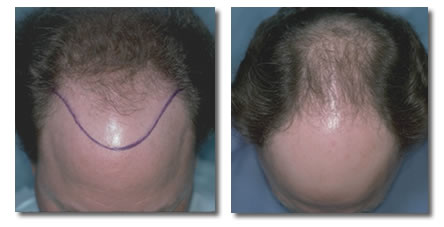
Left: Norwood Class IVa with anticipated hairline drawn.
Right: Early Class Va with some residual hair on the top of the scalp. Note that in both stages there is a complete absence of hair in the front part of the scalp. In both Norwood patterns, the sides and back tend to resist androgenetic changes, although the sides may exhibit significant thinning in old age (senile alopecia.)
Diffuse Patterned and Unpatterned Alopecia
Two other types of genetic hair loss in men not often considered by doctors, “Diffuse Patterned Alopecia” and “Diffuse Unpatterned Alopecia,” pose a significant challenge both in diagnosis and in patient management. Understanding these conditions is crucial to the evaluation of hair loss in both men and women, particularly those that are young when the diagnoses may be easily missed, as they may indicate that a patient is not a candidate for surgery. (Bernstein and Rassman “Follicular Transplantation: Patient Evaluation and Surgical Planning”)
Diffuse Patterned Alopecia (DPA) is an androgenetic alopecia manifested as diffuse thinning in the front, top and crown, with a stable permanent zone. In DPA, the entire top of the scalp gradually miniaturizes (thins) without passing through the typical Norwood stages. Diffuse Unpatterned Alopecia (DUPA) is also androgenetic, but lacks a stable permanent zone and affects men much less often than DPA. DUPA tends to advance faster than DPA and end up in a horseshoe pattern resembling the Norwood class VII. However, unlike the Norwood VII, the DUPA horseshoe can look almost transparent due to the low density of the back and sides. Differentiating between DPA and DUPA is very important because DPA patients often make good transplant candidates, whereas DUPA patients almost never do, as they eventually have extensive hair loss without a stable zone for harvesting.

The progression of male hair loss in Diffuse Patterned Alopecia (DPA) and Diffuse Unpatterned Alopecia (DUPA). In DUPA, the sides thin significantly as well.
Diffuse Unpatterned Alopecia (DUPA) in a 32 year-old male (Left). The densitometry shown (Right) reveals extensive miniaturization.

27 y/o Son | 
Densitometry | 
67 y/o Father | 
Densitometry |
Diagnosis of Hair Loss in Men
The diagnosis of androgenetic alopecia in men is generally straightforward. It is made by observing a “patterned” distribution of hair loss (see the previous session on
Classification) and confirmed by observing the presence of miniaturized hair in the areas of thinning.
Miniaturization – the progressive decrease of the hair shaft’s diameter and length in response to androgens – can be observed using a densitometer, a hand-held instrument that magnifies a small area of the scalp where the hair has been clipped to about 1mm in length.
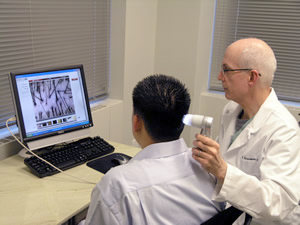
Dr. Bernstein Using the Electronic Hair Densitometer
The photo, below left, was taken from a normal scalp. The follicular units (groups) are made of predominately of full-thickness, healthy terminal hair. Note the relatively uniform diameter of the hair shafts. The photo, below right, shows that many hairs have decreased in diameter (miniaturized). This is characteristic of androgenetic alopecia.
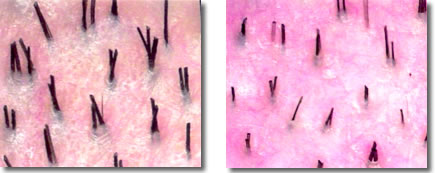
The diagnosis of androgenetic alopecia is supported by a family history of hair loss, although a positive history is not always identified. (see Genetics) In older patients, their own history of passing through the different Norwood stages is strongly suggestive of male pattern alopecia.
If the hair loss is diffuse (thin all over) rather than following one of the specific Norwood patterns, the diagnosis can be more difficult. However, the presence of miniaturization in the areas of thinning usually confirms the diagnosis of androgenetic alopecia. If the diagnosis is still unclear, a number of other conditions must be ruled out.
Medical conditions that can produce diffuse hair loss in men include thyroid disease and anemia. Certain medications, including some drugs used for high blood pressure and depression, and the use of anabolic steroids, can also cause male hair loss.
The following laboratory tests are often useful when a non-androgenetic cause for diffuse hair loss is suspected: blood chemistries, complete blood count, serum iron, thyroid functions, and tests for lupus and syphilis.
When the diagnosis of androgenetic alopecia is still uncertain, further diagnostic information can be obtained from a hair-pull test, a scraping and culture for fungus, a microscopic examination of the hair bulb and shaft, and a scalp biopsy. A dermatologic consultation is warranted whenever the cause of hair loss is unclear.
 Quick Heal Total Security protects your laptops and desktops and provides protection against all kinds of Internet or network-based threats. Upon installation, it acts as a shield against viruses, worms, trojans, spywares and other malicious threats. It also provides security against new and unknown threats with Quick Heal's renowned DNAScan® Technology. Its improved Anti-Phishing feature ensures that you do not land on phishing sites when browsing the net. The Parental Control feature allows you to schedule Internet access for your children and its pre-configured restricted browsing ensures that children do not visit adult sites. The PCTuner tool improves the overall efficiency of your system and the PC2Mobile Scan feature scans, detects and removes malwares from your mobile phones. It utilizes minimum system resources, thereby giving complete protection to your system without slowing it down.
Quick Heal Total Security protects your laptops and desktops and provides protection against all kinds of Internet or network-based threats. Upon installation, it acts as a shield against viruses, worms, trojans, spywares and other malicious threats. It also provides security against new and unknown threats with Quick Heal's renowned DNAScan® Technology. Its improved Anti-Phishing feature ensures that you do not land on phishing sites when browsing the net. The Parental Control feature allows you to schedule Internet access for your children and its pre-configured restricted browsing ensures that children do not visit adult sites. The PCTuner tool improves the overall efficiency of your system and the PC2Mobile Scan feature scans, detects and removes malwares from your mobile phones. It utilizes minimum system resources, thereby giving complete protection to your system without slowing it down.












 inheritance from the maternal side of the family slightly more important than the paternal one (
inheritance from the maternal side of the family slightly more important than the paternal one (







